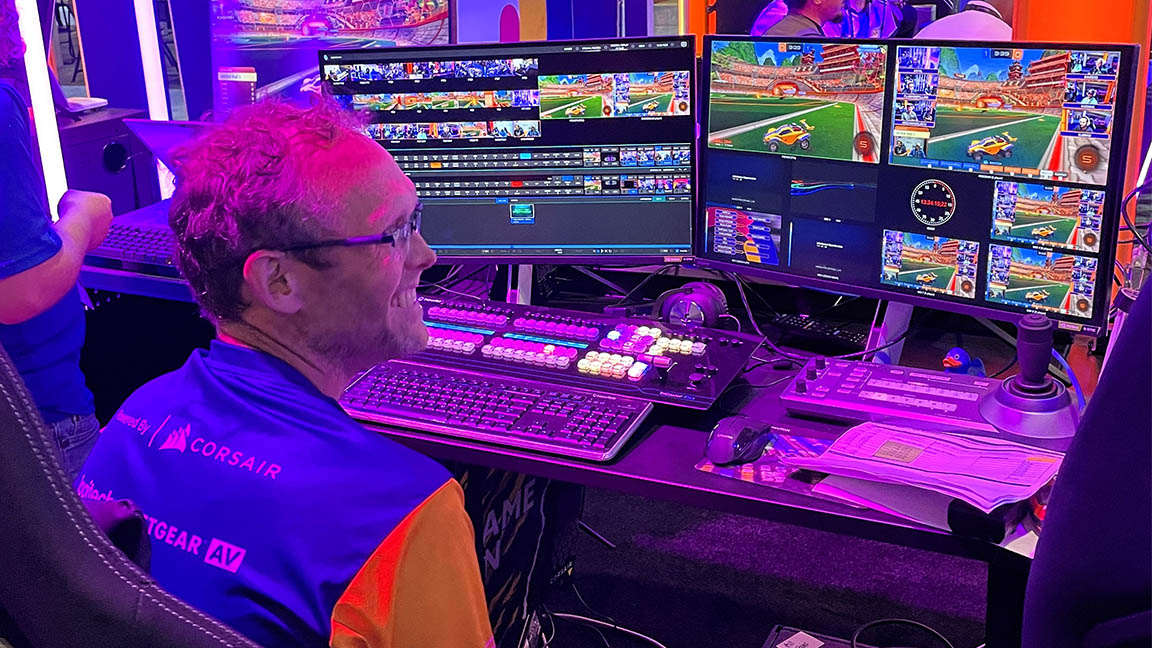Extra Lives for Esports?
While the industry faces post-pandemic changes, it also offers growth opportunities for Pro AV.


Even a very bad situation can have some good results. In the case of COVID-19, one silver lining to the very dark cloud was the rise of esports. Being able to watch champion video gamers compete over the web provided a safe pass time for sports fans, while substantially boosting the popularity of the previously niche competitive industry.
“The COVID-19 worldwide pandemic led to a rise in esports,” said Bubba Gaeddert, president and co-founder of the Videogames and Esports Foundation, a nonprofit organization that provides financial assistance, academic support, and career guidance to students and schools who want to pursue gaming and esports. "Tournaments transitioned online and expanded globally, with new protocols and enhanced connectivity rapidly implemented to meet the increased demand for online gaming.”
[Time to Unpack: 5 Talking Points from InfoComm 2024]
When COVID-19 receded, so did esports’ fortunes. “After the pandemic settled down and people got back into large spaces again together with or without masks, we started to see consolidations, layoffs, and sponsorships not renewed,” Gaeddert recalled.
He’s not alone in his assessment. In May 2023, the New York Times reported that League Championships Series viewership (esports’ version of the NFL) dropped significantly in 2022 and 2023. The drop resulted in reduced advertising support, and professional leagues have struggled to turn a profit.
But all is not bleak for esports. According to Statista.com, the global esports market worldwide is projected to reach a revenue of $4.3 billion this year, with a compound annual growth rate (CAGR) of 7.1% that will result in a projected market volume of $5.7 billion by 2028. And that’s just for the pros: These numbers don’t cover the growing esports presence on college campuses or K-12.
Tournament of Challenges

Professional esports tournaments matter most to the Pro AV industry, due to the sophisticated AV equipment required to broadcast events in stadiums and online. Case in point: “IHSE USA works with some of the best game developers in the world and offers them a full range of products from basic broadcast in live esports tournaments to high frame rate extenders,” said Dan Holland, the company’s marketing manager. “For competition gaming stations, which must be located at distances that exceed the reach of copper cables, IHSE’s Draco ultra DP Gaming Extenders [KVM display management extenders that support refresh rates up to 240 Hz] ensure gamers and esports players see sharp visuals during fast-action gameplay.”
A daily selection of the top stories for AV integrators, resellers and consultants. Sign up below.
Existing facilities like HyperX Arena Las Vegas are already setting the standard for advanced AV technology, according to Joe da Silva, VP of marketing at Extron. He said upcoming developments, such as a proposed esports arena in Philadelphia, will further elevate the esports experience with innovative AV solutions.
“Esports presents significant growth opportunities for the AV industry, becoming a key revenue driver for us due to its rapid expansion and diverse market segments,” da Silva explained. “As such, AV companies like Extron can offer specialized solutions tailored to the unique demands of esports. This includes large-format video walls, switchers, streaming devices, professional audio equipment, and integrated control solutions to manage lighting, sound, and displays seamlessly—and to ensure smooth gameplay, clear communication, and immersive experiences for both players and spectators.”
Back to School
Although the professional leagues in any sport tend to dominate people’s attention, college and K-12 sports also matter. This is as true for esports as it is for football, basketball, and baseball. In fact, esports are extremely popular in both these market segments, opening up more sales opportunities in this market for Pro AV equipment manufacturers, installers, and integrators.
[DMS: Next-Gen KVM]
For example, take Horizon AVL and Esports Integration, a systems integrator based in Blackwood, NJ. “Our concentration is building up the esports community and industry from the ground up, meaning we focus on the esports industry in K-12 and higher education,” said CEO Joshua Kell. “K-12 institutions are increasingly investing in esports programs, running local events and tournaments up to statewide events and championships. In fact, more than 70% of high schools now have some form of esports program.”
“Esports at the K-12 and college levels are increasingly popular, offering students organized gaming competitions ranging from school leagues to collegiate championship,” agreed da Silva. “Schools such as Canyon Springs High School [in North Las Vegas, NV] and Compton Unified School District in California are integrating esports into curriculums to teach valuable skills. Scholarships attract top gaming talent, raising the level of competition. Companies provide financial support and equipment, while local businesses partner with schools to sponsor teams and events.”
There are around 200 colleges and universities that have video gaming as part of their curricula, Holland said. “With the growing interest in esports, these institutions are looking at alternative programs to attract potential students. Many of them support esports teams with scholarship opportunities," he explained. "Meanwhile, more than 8,600 high schools have started gaming teams according to the National Education Association. Educators are working with technology companies and professional AV providers to bring cutting-edge equipment to their video gaming programs.”
“The scholastic esports industry continues to triple each year. The largest collegiate esports event in the world happened for the fourth time this May in Arlington, TX, at the Esports Stadium Arlington, with four Champions colleges in Overwatch, Valorant, Smash Bros, and Rocket League," Gaeddert reported. "There were 224 PCs on site, with an attendance of 4,095, 11,000 average concurrent viewers [CCV], and 4.1 million views on Twitch with over 175,000 chatters.”

The popularity of college/K-12 esports is not just good for enrollment and student engagement, but educational success as well. “Students are more engaged in their studies, attendance rates are rising, and higher education institutions are experiencing increased enrollment due to their esports teams and improved academic outcomes,” said Kell. “While STEM remains a focus, our primary emphasis is on career and technical education [CTE]. Our curriculum begins as early as 5th grade and extends through 12th grade, providing students with industry-recognized certifications that prepare them for the workforce or future careers.”
[Installation Spotlight: 4 Things to Know about Wake Tech's Esports Venues]
“Esports can offer students advanced options in their education programs through STEM programs,” Holland added. “The U.S. military is working with local high schools and universities who have esports programs in an effort to attract those who would have interest in countering cybersecurity threats.”
Learning Curve
Esports is likely to survive and thrive past its post-COVID downturn, as well as serve as a growing market for the Pro AV industry. That said, there is a learning curve associated with achieving Pro AV success.
"The AV industry requires experts who can understand and translate the specific needs of esports event operators, especially when utilizing spaces designed for large productions with concert-level lighting and sound," said Gaeddert. "These experts must address the significant demands of internet connectivity and power for up to 400 computers in a single room. This need is far greater than the power required to just run a concert on a stage, often requiring four times as much for all the gaming PCs and consoles. Additionally, they must consider the design, lighting, and audio needs for the 'pit,' where non-main stage games are played."
Not all Pro AV plays well in esports, either. “As experts in consulting and building esports facilities, we have identified a significant gap between the requirements of gaming and the support provided by AV manufacturers,” Kell explained. “To address this, our team has developed an internal certification process for products, grading them to ensure they are the best fit for outfitting an esports facility. Given the number of venues we have in the pipeline, it's crucial for AV manufacturers to gain a deeper understanding of this rapidly growing market.”
[15 Thought Leaders on Esports]
Given its projected global revenues, esports should be considered a key growth market for the Pro AV industry. It's certainly a primary focus for Horizon AVL. “Esports now accounts for more than 50% of our entire revenue, making it a crucial vertical for our business,” said Kell. “[Yet] the AV industry is only beginning to recognize esports as a viable vertical.”
James Careless is an award-winning freelance journalist with extensive experience in audio-visual equipment, AV system design, and AV integration. His credits include numerous articles for Systems Contractor News, AV Technology, Radio World, and TV Tech, among others. Careless comes from a broadcasting background, with credits at CBC Radio, NPR, and NBC News. He currently co-produces/co-hosts the CDR Radio podcast, which covers the Canadian defense industry. Careless is a two-time winner of the PBI Media Award for Excellence.

